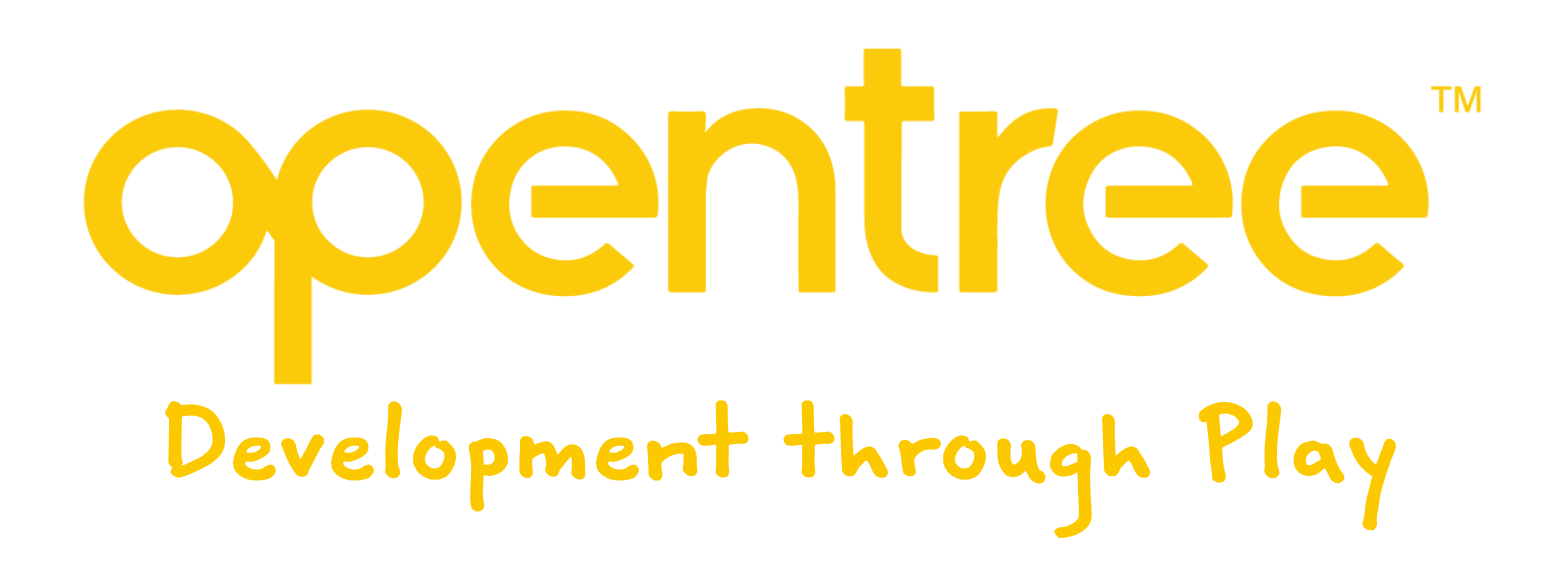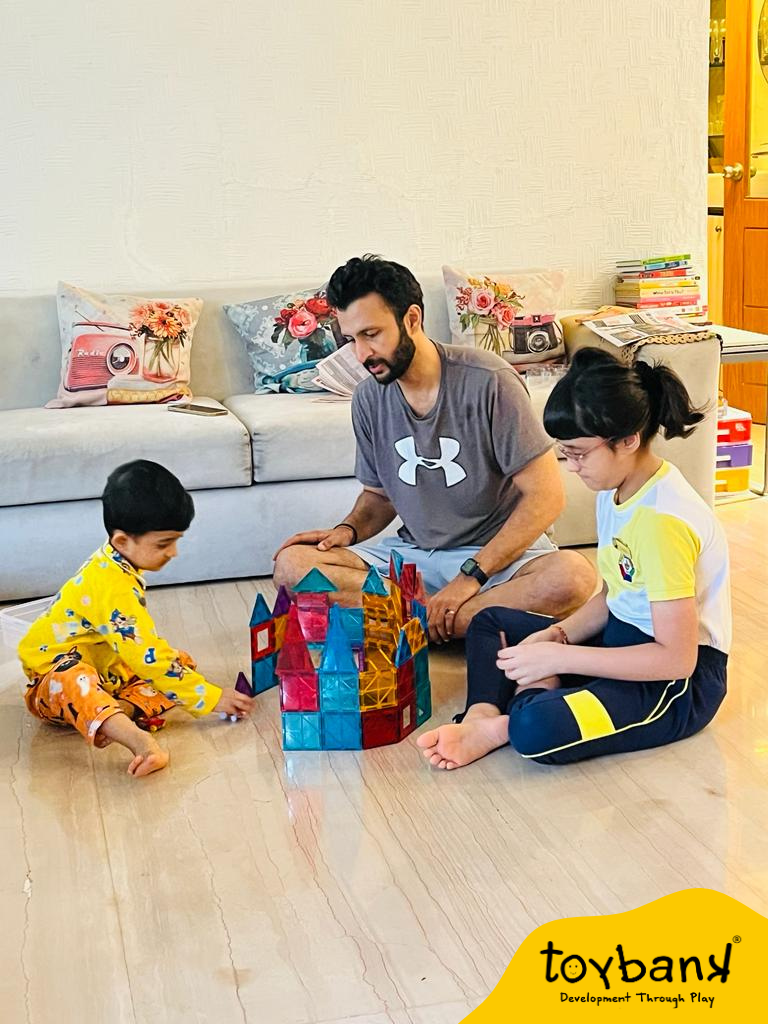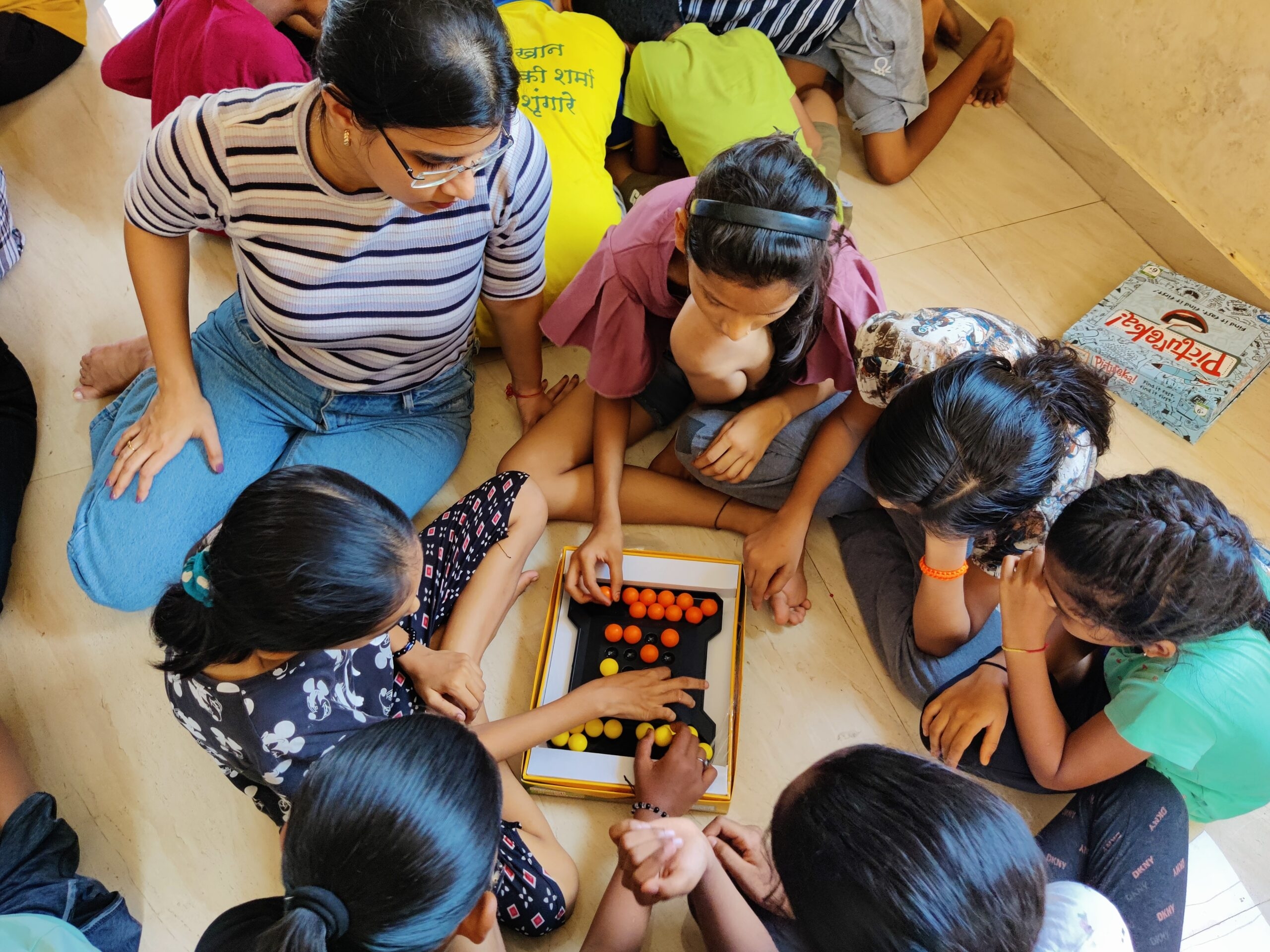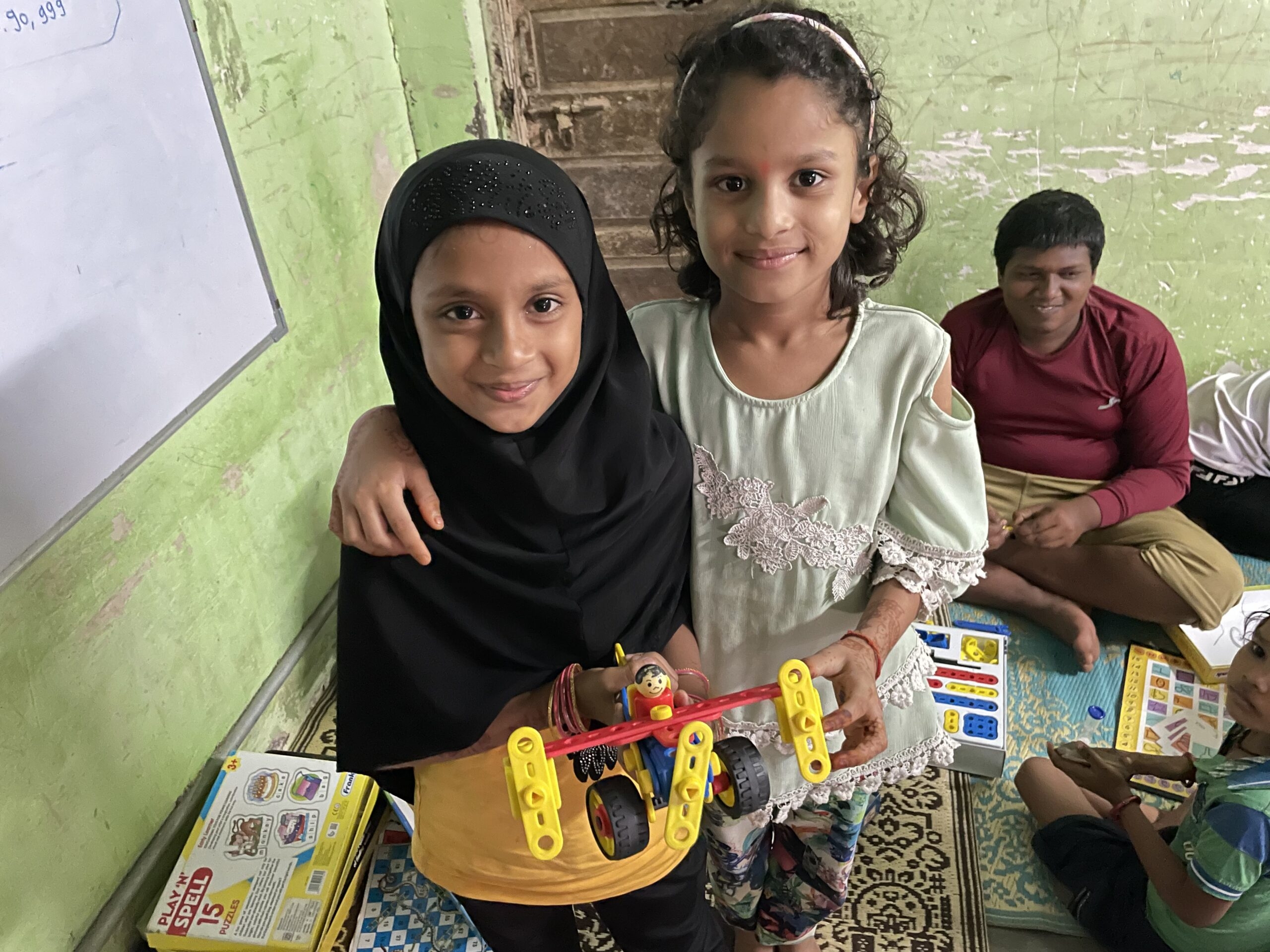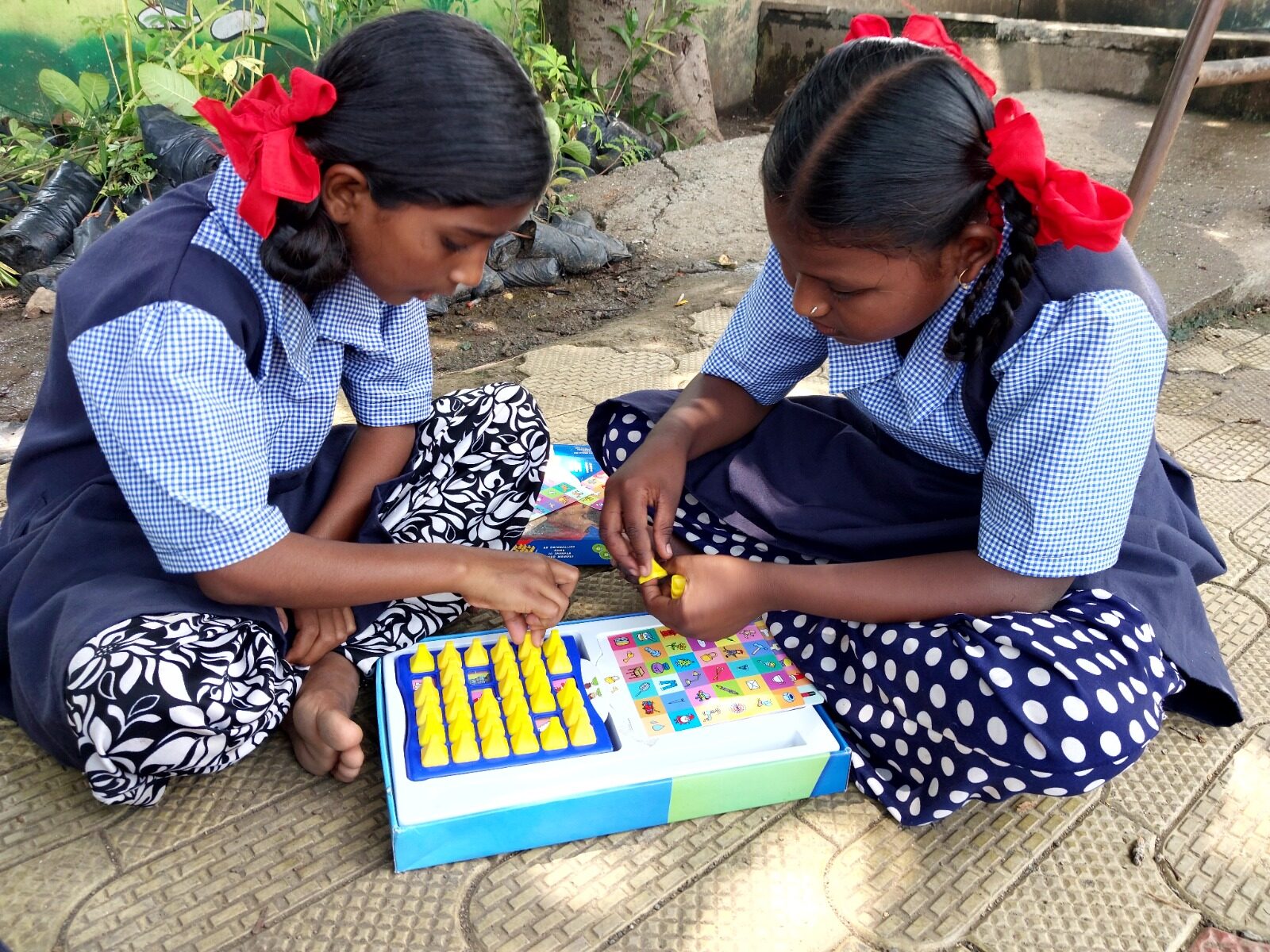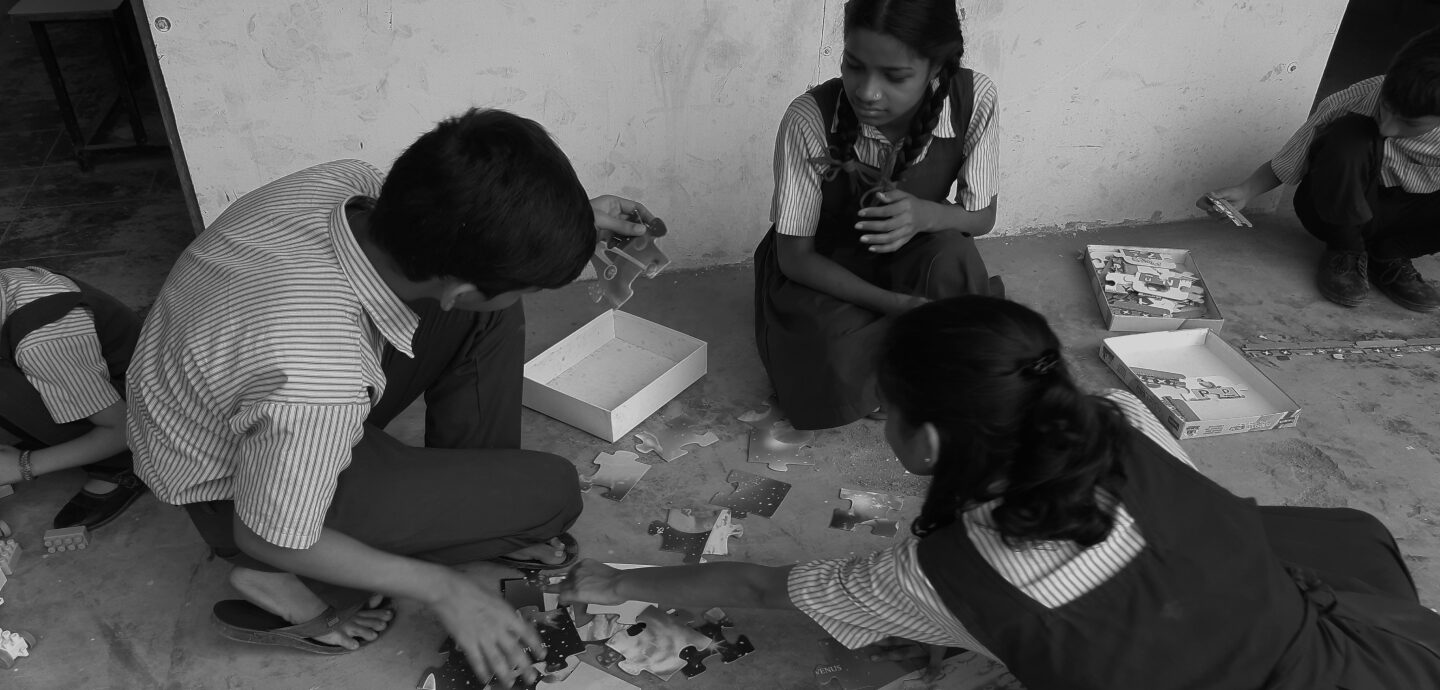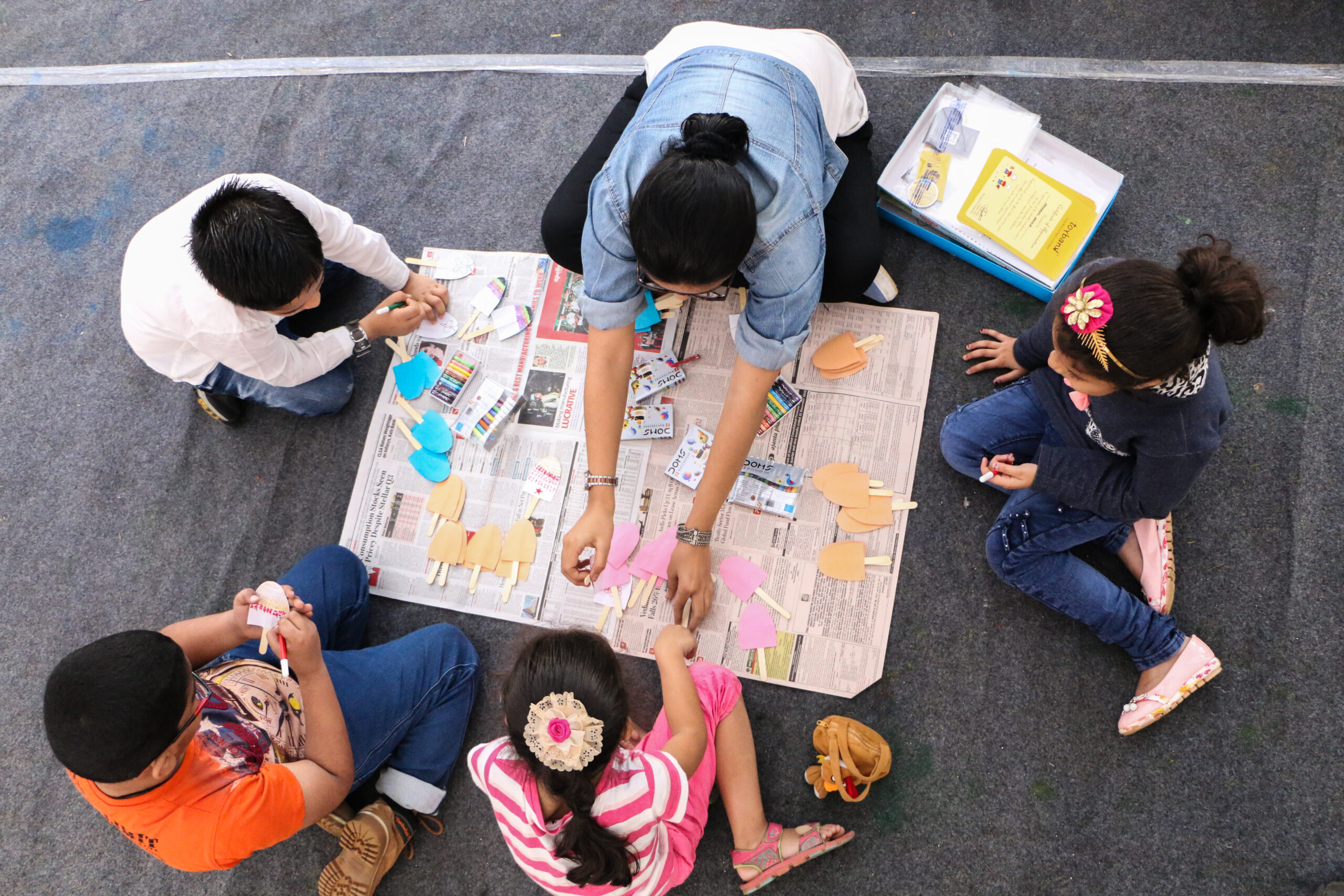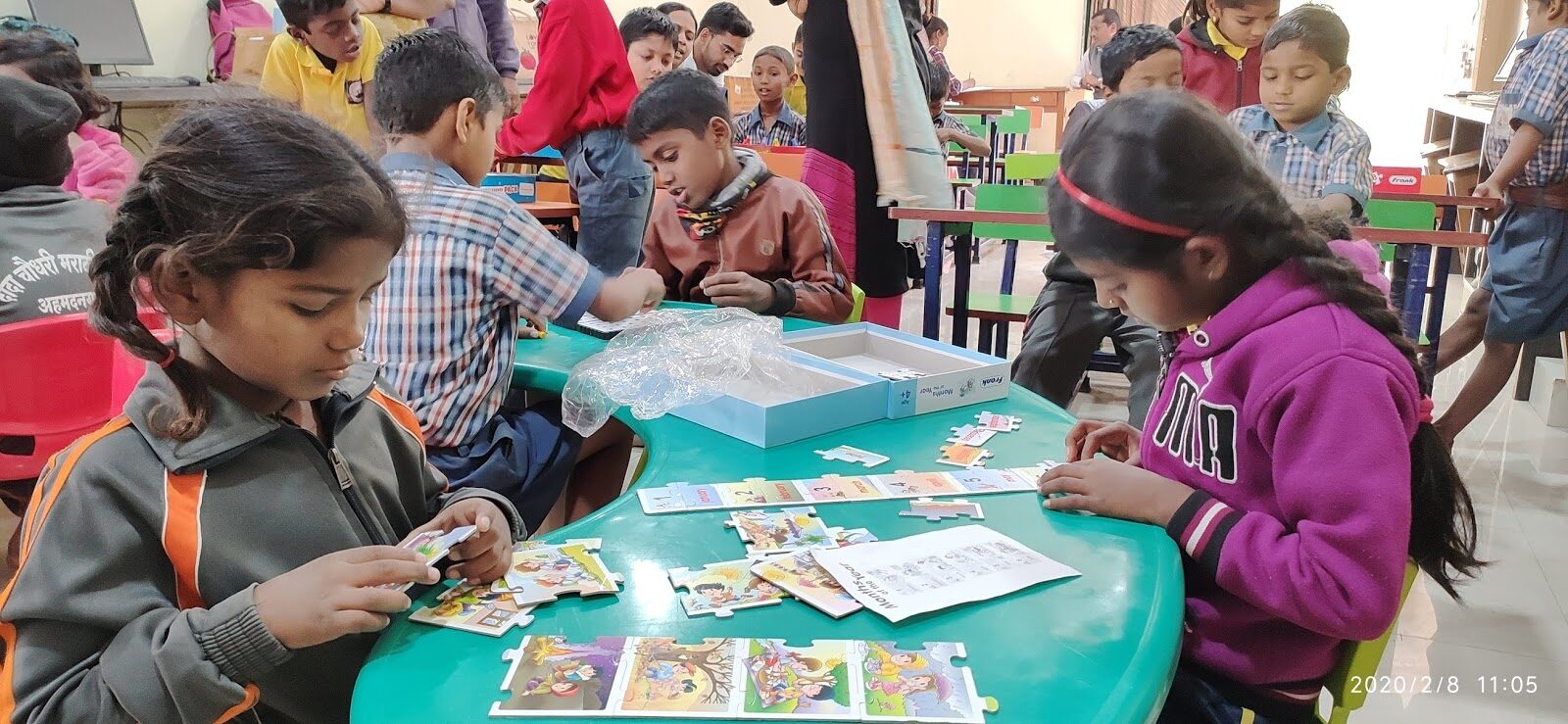Category: RESEARCH
Playful Parenting: How Play enables parents to better connect with children
Play does not mean we need to go out or play with toys. We can do anything because Play is everything.
Play during childhood contributes to children’s development in significant ways. It is socially interactive and a way for children to adopt social norms needed to thrive in society: collaboration, empathy and self-awareness among others. Play is also a means for parents to enrich their relationship with their child. It allows parents to observe their children and understand their actions. When playing together, children are not just having fun, but are building skills of communication and collaboration that will benefit them in the long-run.
Research has shown that Play causes the prefrontal cortex to become bigger and work faster. The prefrontal cortex is responsible for ‘higher’ brain functions such as intelligence, decision-making, problem-solving, and emotion regulation. It is also associated with the social skills and personality of humans.
We spoke to a few parents on what different play methods they have adopted and how play has helped them connect with their child.
‘Letting the child explore surroundings is equally important as toys and games’
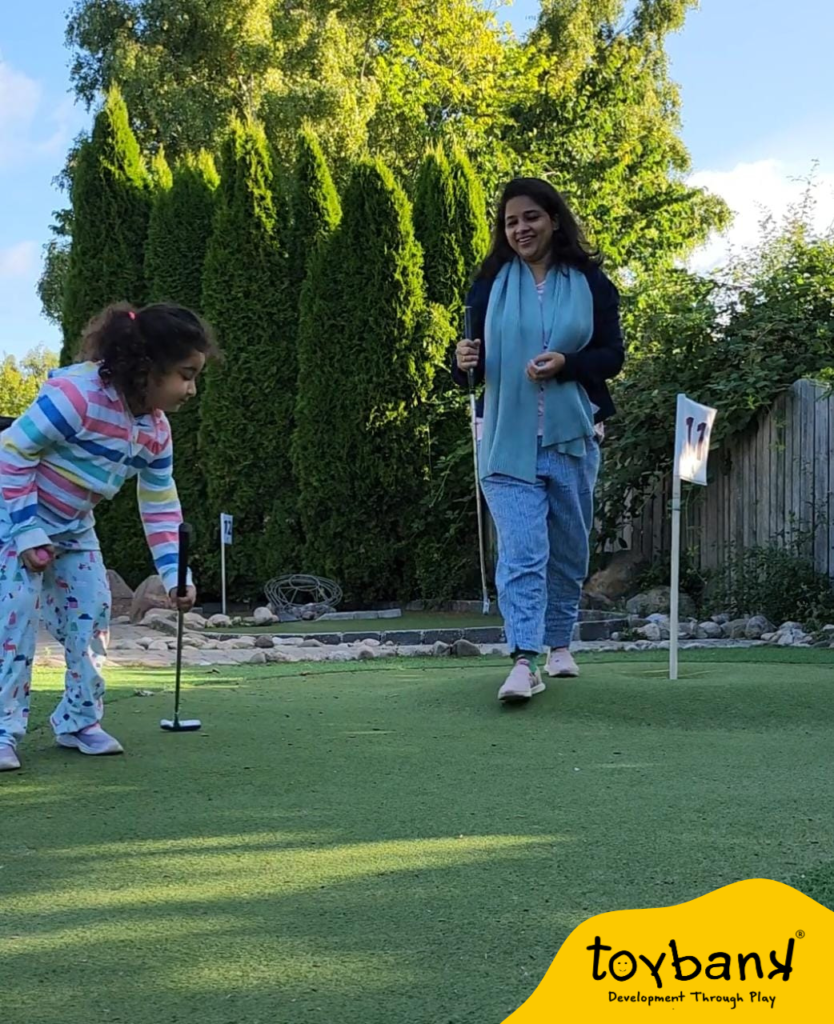
Meghna Pandit did not send her daughter, Myra, now six-years-old, to a playgroup, as she did not want to restrict her thoughts and learning at that age. “Instead, we focused on self-development through Play,” she says.
Like all children, Myra was more interested in the packaging of a toy, than the toy itself. When they stepped outside, the mud or sand in the garden would fascinate her more than the swing. “However, we did not stop her and allowed her to explore her surroundings, while keeping a watchful eye that she was not going overboard,” says Meghna.
In her day-to-day activities, she ensures that Myra is allowed to choose what she wants to play, as this allows children to feel like they have the power and control over what they do. “It is important that parents allow children to explore rather than force toys and games on them,” she says. They also saw to it that there were times when Myra was playing independently, as playing by themselves helps foster children’s imagination and enhances their problem-solving skills.
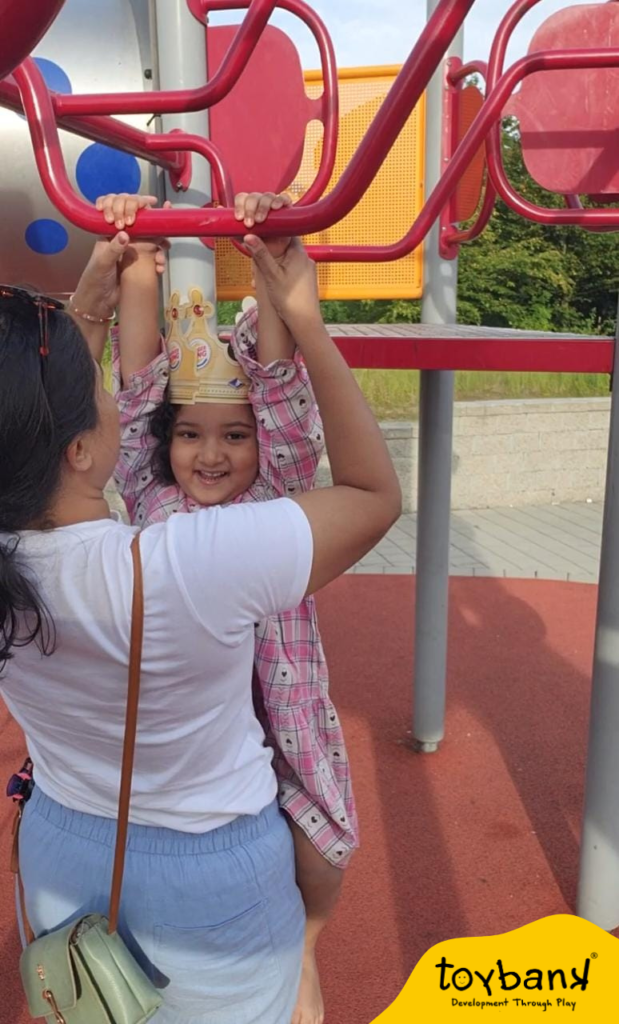
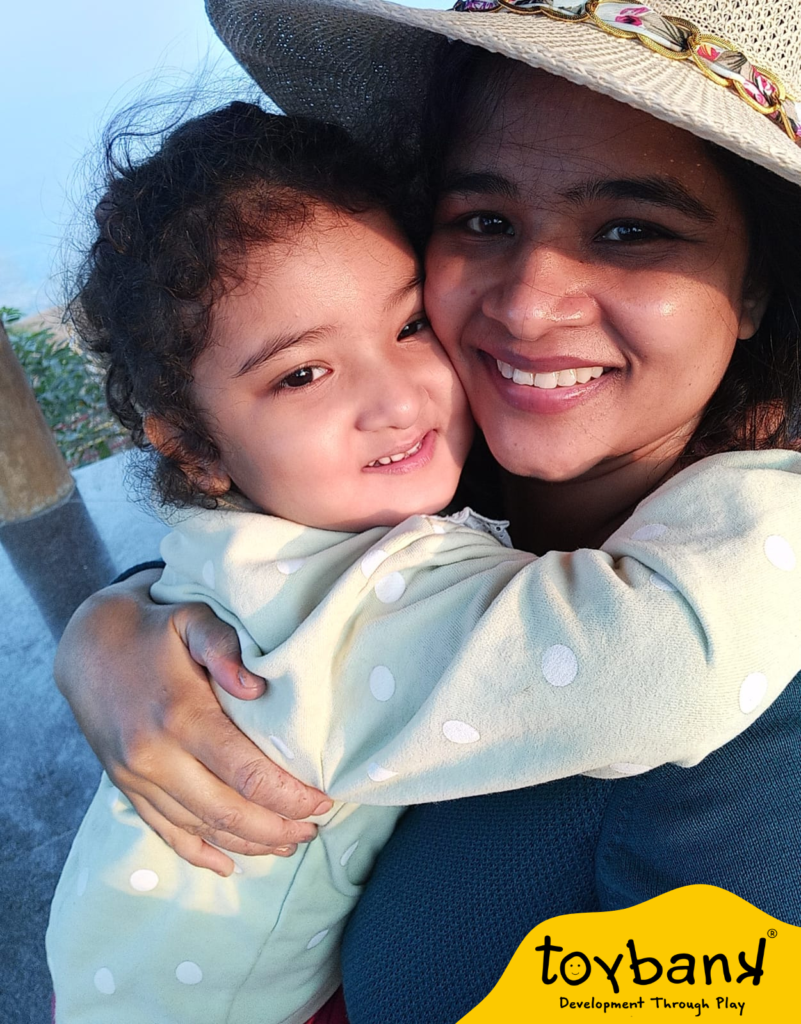
To help Myra develop certain skills, Meghna and her partner chose a few games strategically. “We chose games such as Mechanix and Tool Kit to help her develop fine motor skills, and puzzles helped her in developing strategy-based thinking,” she adds. They also ensured that Myra had games, which required her to play in groups in order to help her develop skills such as collaboration and communication. “We used the children’s bowling game for this purpose.” They also broke the barrier and did not differentiate between games based on gender.
Meghna says that Play has taught Myra to be fair. She did not know that her daughter had developed this skill, until she noticed it during a play session with friends. “In a group game, she ensures that all her friends get equal opportunities.”
Through her years as a parent, Meghna has realised that Play is vital in a child’s formative years. “It gives them an opportunity to explore and be creative rather than restrict their thoughts in the direction you want,” she says. “This in turn also brings out their character, personality and that’s important as they grow older.
Bonding is essential for a parent and child, and what better way to do that than Play?
‘Play is as important for parents, as it is for children’
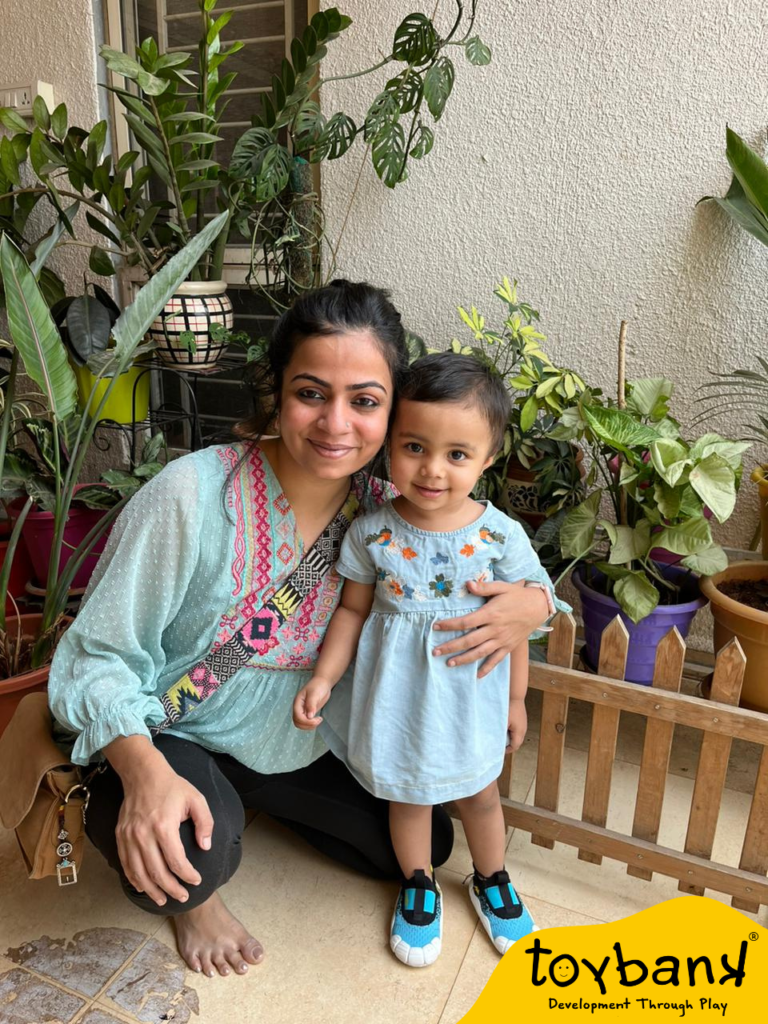
Shalvi Mangaokar works from home and ensures that she removes some time every few hours to play with Snitika, her two-year-old daughter. She says that Play is an essential part of a parent’s life, just like it is for a child. “Most parents, including myself, do not always know how to play with a child, so it is important that we read up about the different ways of play and how it benefits the child,” says Shalvi.
When a parent plays with a child, the parent’s attention is entirely on the child. “Play helps me bond a lot more with Snitika, and also allows me to distract myself from my everyday life,” she adds.
Shalvi uses a lot of sensory play, as it encourages learning through exploration, curiosity, problem-solving and creativity. “I believe sensory play is a significant part of child development, especially because it works a lot on developing the sensory, cognitive and fine motor skills of children before we get into understanding their left and right brain inclination,” she adds. “It’s important to let them explore things for how they are and grow with them.”
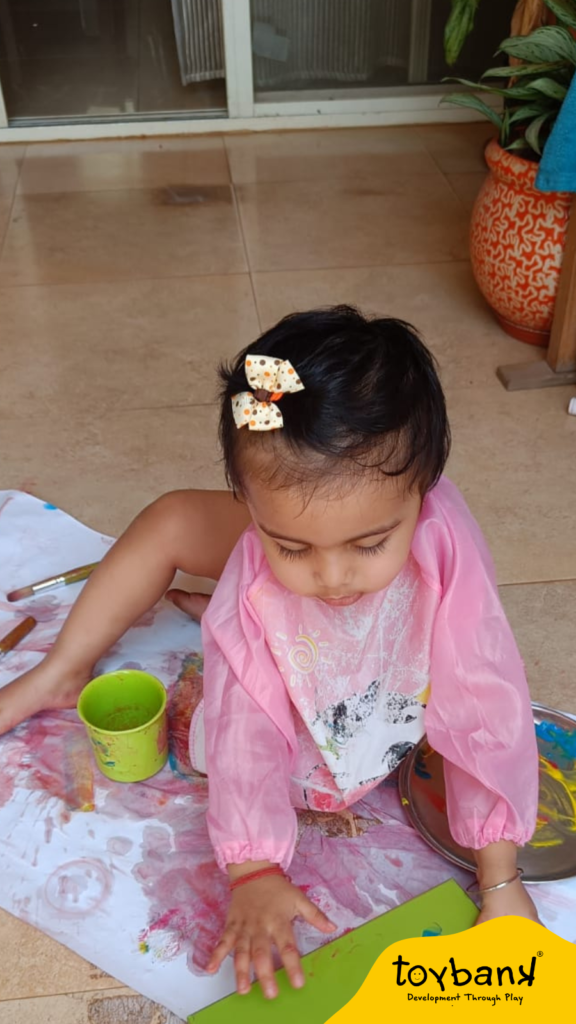
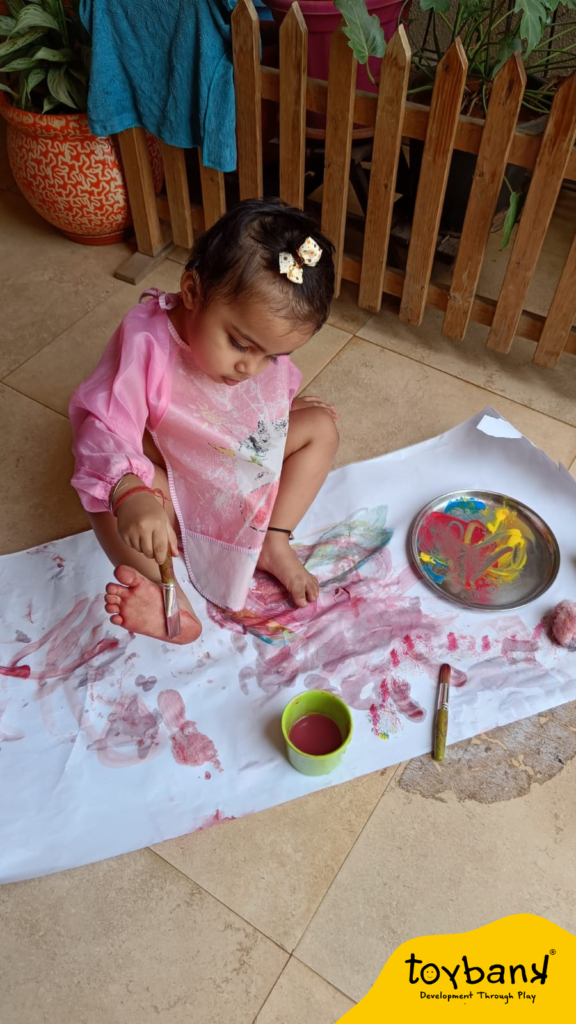
Play is the best way to learn and it brings out the child in everyone.
Shalvi also says that toys aren’t always a necessity for children to play, because for children everyday objects are also play. When she introduced her toddler to touch-and-feel and other books, her objective was not for her to learn the alphabets, but for her daughter to understand the world of books. “Reading to her is also a form of play, as it allows me to bond with Snitika,” she adds.
As a family, they ensure that they play together everyday. This could include involving her in the day-to-day chores or going outdoors. Together, they also turn everyday objects into imaginary things and role play. Research has shown that role play allows a child to exercise their brain and allow it to use imagination at an early age. It also enriches their language and enhances communication skills. Shalvi also ensures that Snitika is introduced to the traditional games such as hide-and-seek, among others.
Play has helped her realise that Snitika is someone with sharp observational skills and quick thinking. “When she is involved in an activity, she does not get distracted easily,” says Shalvi. “I have enjoyed watching her be focused.”
‘Play does not mean we need toys, play is everything’
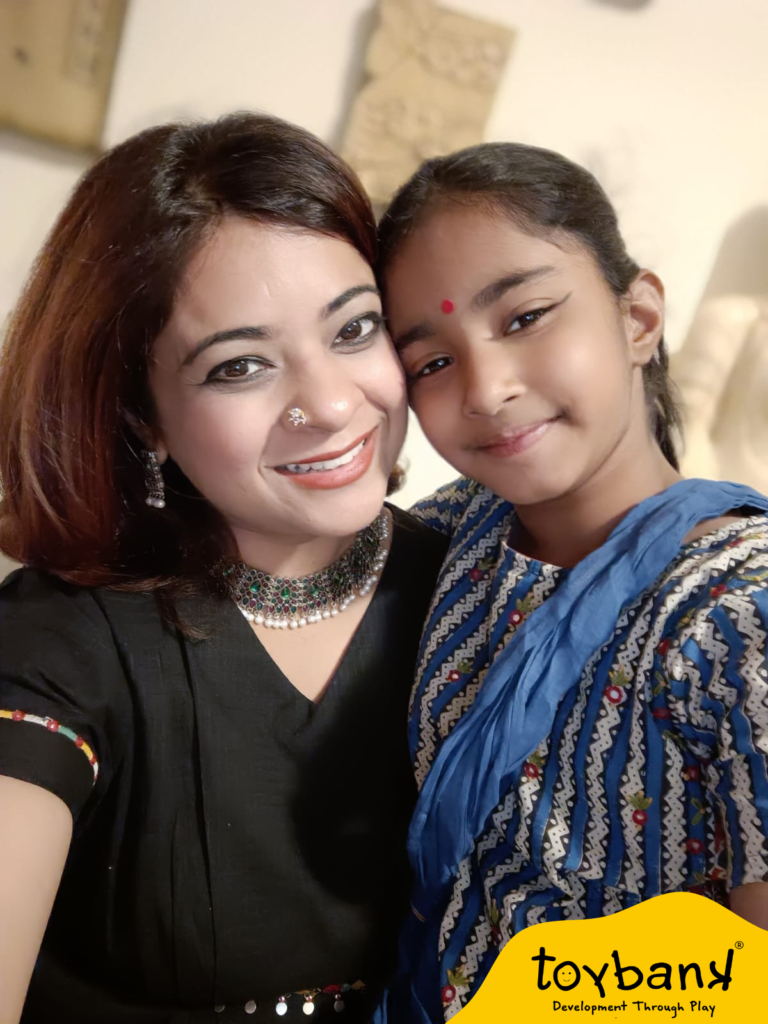
Sarah Stephanos’ eight-year-old daughter Ishani Basu is a play enthusiast and loves outdoor games. “Play is part of our every day, come what may,” says Sarah. Origami, lock-and-key, football, basketball and Brainvita among others are only a few ways they play together. Sarah accompanies Ishani in games such as Catch-And-Cook and Fire in the Mountain, too.
Since Ishani is a lot into outdoor games, playing football is one of her favourites, and this has also taught her to think strategically, and teamwork. “She very easily becomes the decision-maker and tells the team who will play at what position, depending on their skills. I see that playing football with the team has helped her develop her leadership skills.
Sarah says that play allows her daughter to explore her creativity and thinking, rather than following a certain style or pattern. “When she was younger, I introduced her to origami as it helps with finger movement and developing certain cognitive skills.”
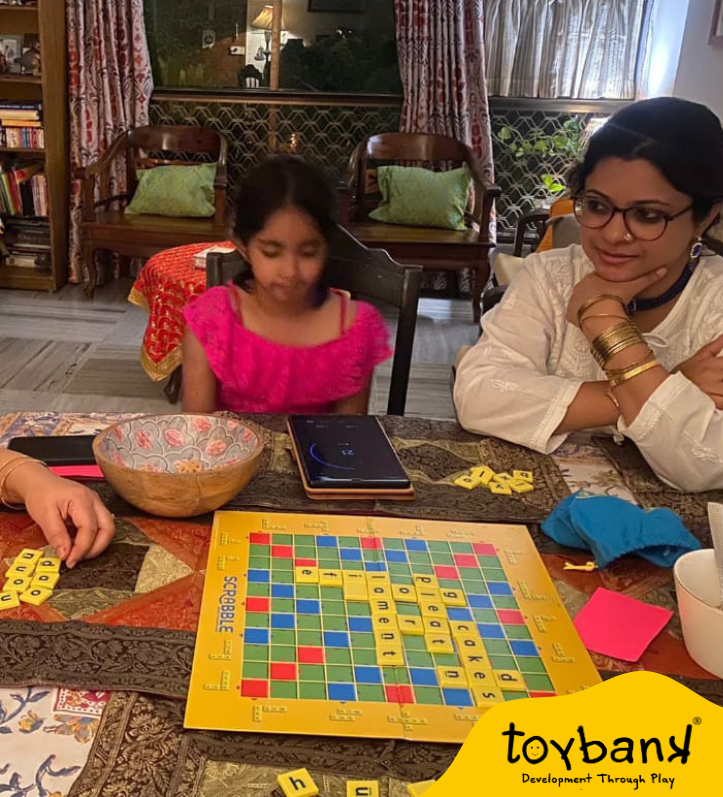
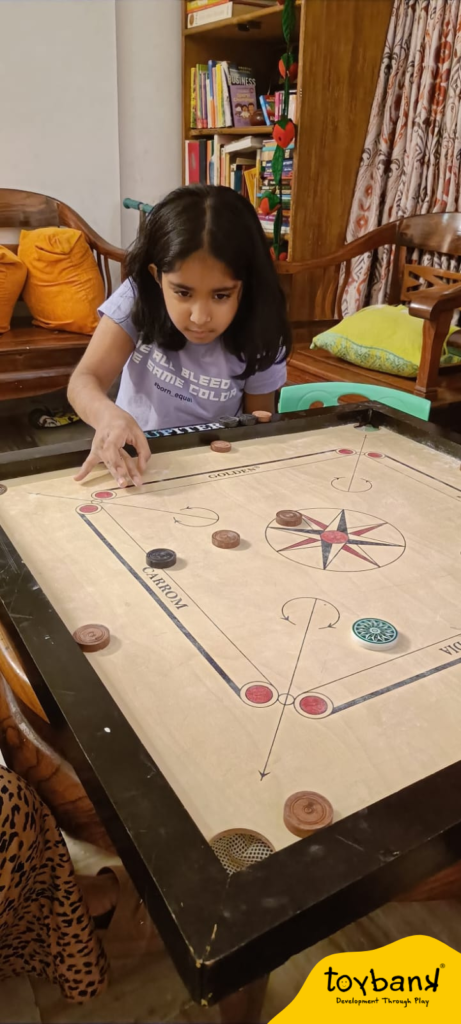
Through play, Sarah has taught her daughter that it is okay to lose. “Initially, when she played the game snakes and ladders, I used to let her win,” she says. “Since this became a habit, it made me realise that she did not like to lose. Following this, I started letting her lose and taught her that it was okay to lose, while associating the feeling to real life situations.”
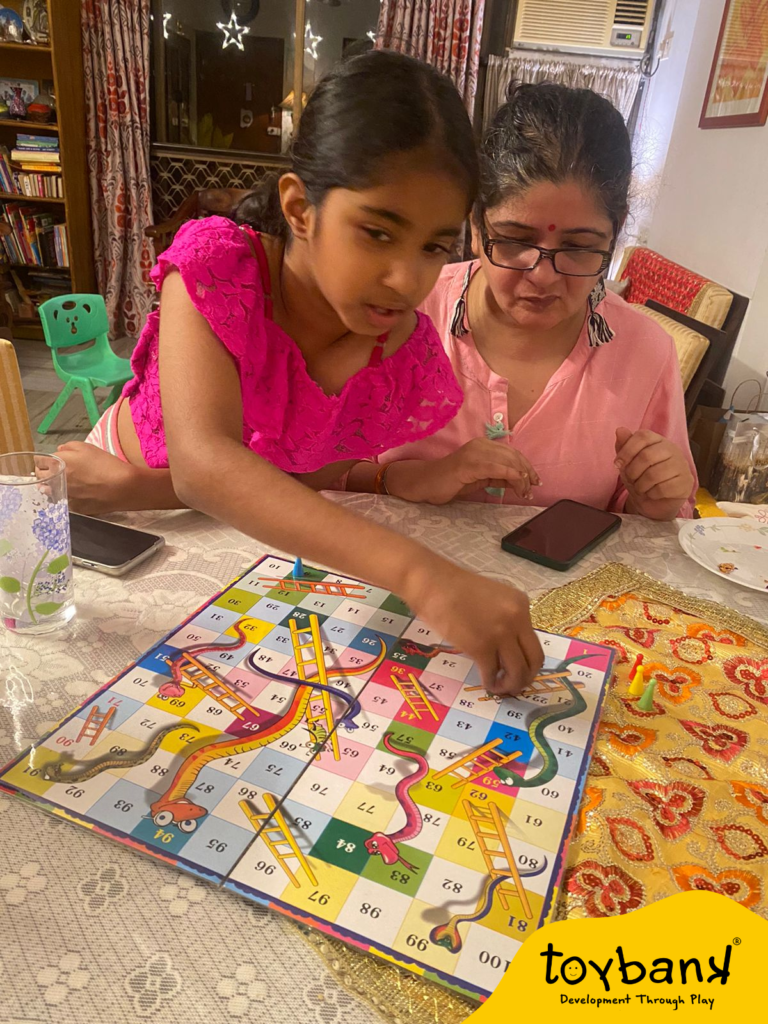
Play has made Ishaani very observant and helped her think out of the box. Sarah narrated one such incident, where Ishani pointed to a dry leaf and told her that the positioning of the leaf made it look like a bird. “Sometimes it fascinates me how children think and I also realised that Ishaani is always thinking out of the box,” Sarah adds.
As a parent, she has noticed that people often say they have no time to play. “Play does not mean we need to go out or play with toys. We can do anything because Play is everything,” she says. “Bonding is essential for a parent and child, and what better way to do that than Play?”
‘Play brings out the child in everyone, helps us destress’
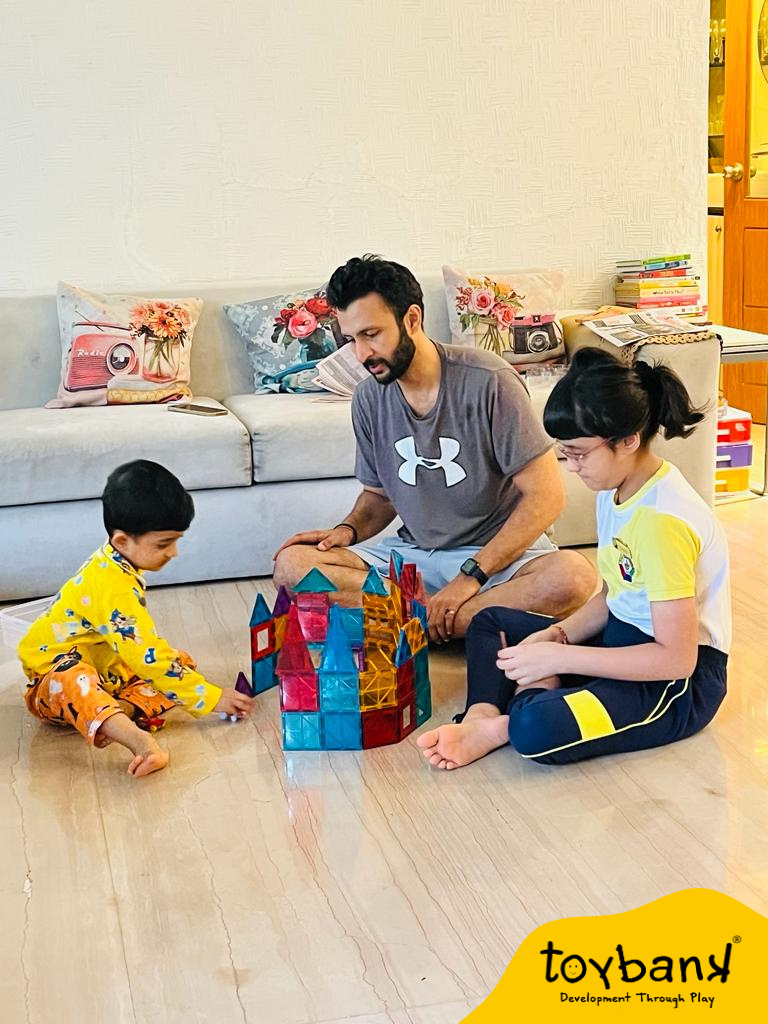
Priyam Agarwal is a mother of two: 10-year-old Sairah and three-year-old Sriihaan, and lives in a joint family. “When we go out on trips, we always ensure that we play together, even if it’s just cards.”
For Priyam, Play is a way to destress from her everyday life and at the same time, have her children learn constructively. “I ensure that we invest in educational games and toys such as those that help understand science and other subjects of their interest,” she adds.
As a child, Sairaah was always interested in puzzles and Legos. While the puzzles allowed her to develop strategic thinking and problem-solving, Legos gave her time to explore her creativity. “Her current favourite is Magna tiles. And, Sriihaan is into cars. So, the two of them get together and build different structures such as car garages or a parking lot, using the toys they have,” adds Priyam.
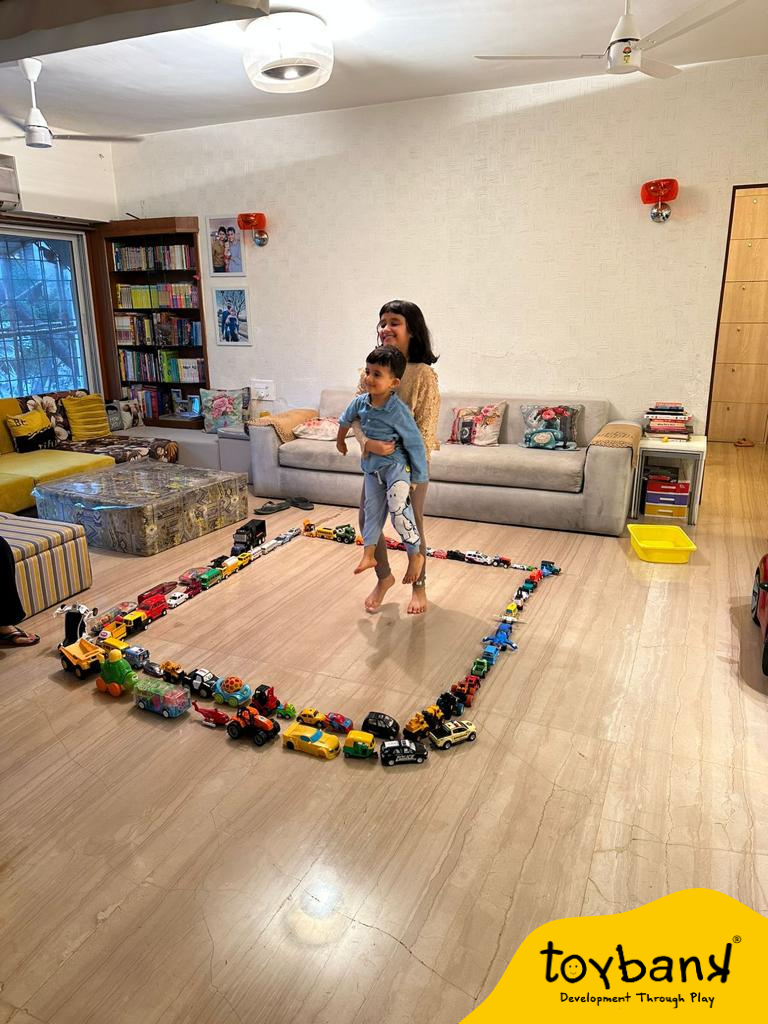
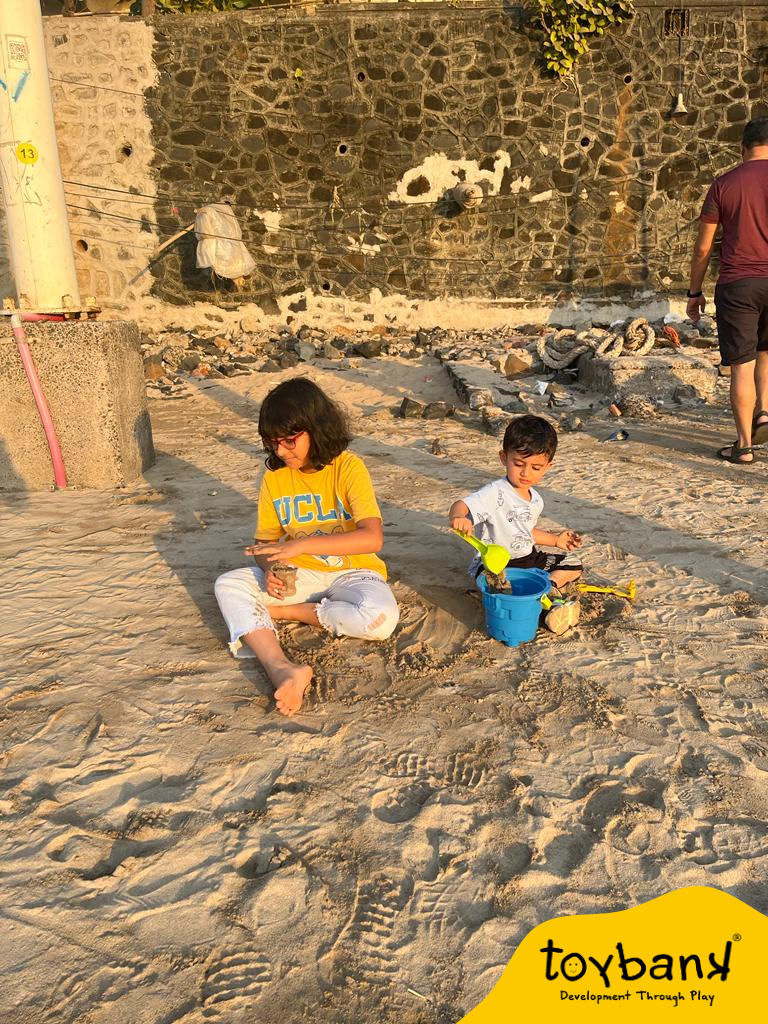
They also ensure that outdoor activity is part of their play, and since they live close to a beach, getting their hands dirty in the sand is a weekly activity.
Priyam recalls the Covid-19 induced lockdown and while it was a difficult time for everyone to be locked in their homes, she spoke about how Sairaah was the one that took the lead and came up with games for everyone to play together. “Sairaah would engage us in her games such as charades, pictionary, or just the usual Name-Place-Animal -Thing. Sometimes, she would give us an alphabet and ask us to name countries, cities or food items beginning with that alphabet. Play made lockdown a little less stressful for us,” she says.
Role play is another important aspect of child development, as it allows the child to develop social and thinking skills. It also helps them make decisions and practice and develop their physical skills. For this, Priyam had bought a doll house for Sairaah when she was five-years-old and today, both her children continue to play with it.
While Sairaah is now old enough to play by herself or wants to play with her friends more, Priyam ensures that she always makes time to Play and learn with Sriihaan. She says that play is the best way to learn and it brings out the child in everyone. “Play is important because sometimes we are so serious in life, so stressed out, and play helps us destress,” she adds.
Play gives children a chance to practice what they are learning.
Play helps children build skills to become creative, engaging adults
Play is the primary way in which young children connect and engage with the world around them. Through play, children may imagine and explore a world they can control, thus overcoming their fears. When playing together, children are not just having fun, but are building skills of communication and collaboration that will benefit them in the long-run. As we move into adulthood, our definitions of play change, but many motivations remain the same, which help us form a framework of play across ages.
Beginning in the first year of life, play becomes an infant’s primary mode for engaging with others and with the world, setting the bar for interactions with the world to be as pleasurable as play throughout the life-span. Attuned play encourages a child to grow up to be a playful adult who experiences life as a playground. This is not only an expression of healthy development, it is also an inherent characteristic of homosapiens. Unfortunately, not every child is so lucky. According to the original research on attachment styles conducted by psychologist Mary Ainsworth, up to 50 percent of individuals do not have secure attachment experiences. Without attachment security, these children are much more likely to grow up seeing the world as a proving ground, a battleground, or a prison. These worldviews can become self-fulfilling prophecies, establishing feedback loops that engender the world the child expects.
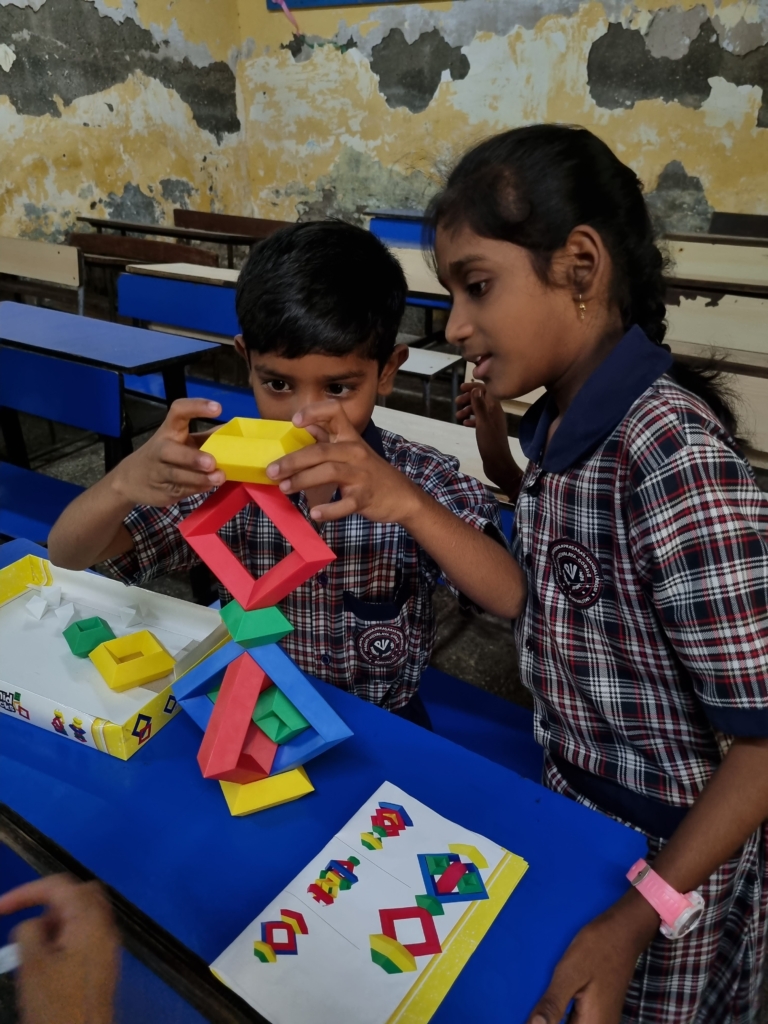
In the past few decades, research has repeatedly shown that play experiences are not merely fun, nor just a way to pass the time along the way to adulthood. Instead, play has a central role in learning and in preparing you for challenges later on in childhood and through adulthood. The Russian developmental psychologist Lev Vygotsky says that play is essential to the growth of what is referred to as “symbolic representation”. The ability of humans to use different types of symbolic representation for culturally significant purposes is the foundation of human thought, culture, and communication.
Psychologist Sigmund Freud has also correlated early-childhood experiences with mental health in adulthood; but only in the last half century has play been included as one these formative childhood experiences and a factor in healthy development.
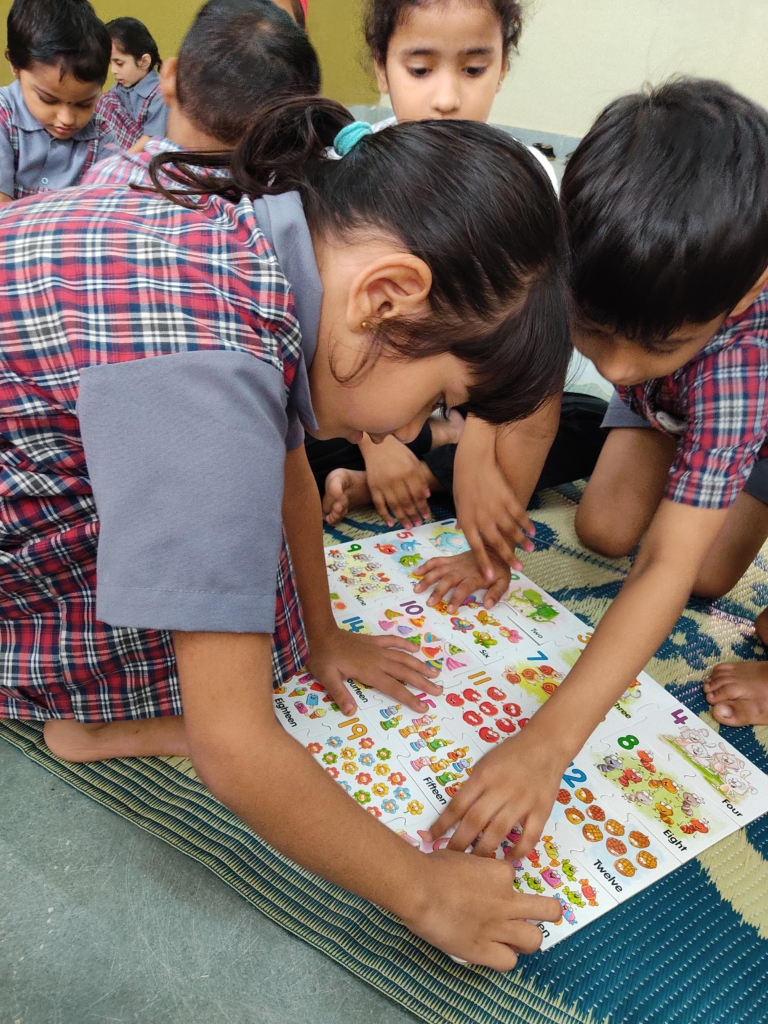
Today’s world is uncertain and constantly changing. Children need skills and mindsets allowing them to step into this uncertainty, create opportunities for themselves and their communities, and learn throughout life. Using the simple, yet compelling words by researchers Golinkoff & Hirsh-Pasek (2016), realising children’s potential in the face of this uncertainty means supporting them to be “happy, healthy, thinking, caring, and social children who will become collaborative, creative, competent, and responsible citizens tomorrow”.
In playful experiences, children tap into a breadth of skills at any one time. A game of hide-and-seek helps them to manage feelings about the unknown, while also helping them to think about what other people know and see. Beyond enjoyment, playful experiences have the potential to give children the skills they will need in the future that go beyond facts. Playful experiences appear to be a powerful mechanism that help children not only to be happy and healthy in their lives today, but also develop the skills to be the creative, engaged, lifelong learners of tomorrow.
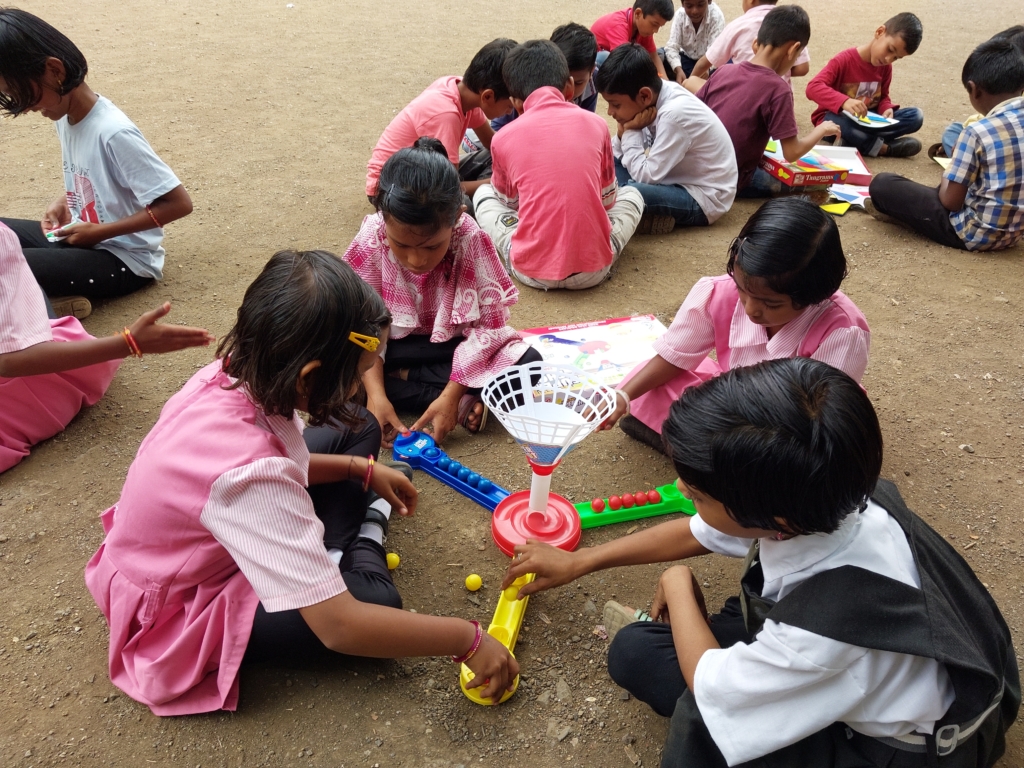
The benefits of playfulness in adults overlaps in many ways with those for children, including enhanced creativity, humour, motivation, and positive effect. In addition, playfulness predicts numerous health benefits in both children and adults. Research shows that playful adults live an average of 10 years longer than their less playful peers. Perhaps most significant of the benefits conferred by a playful approach to life is its relationship to stress reduction and coping strategies in adults.
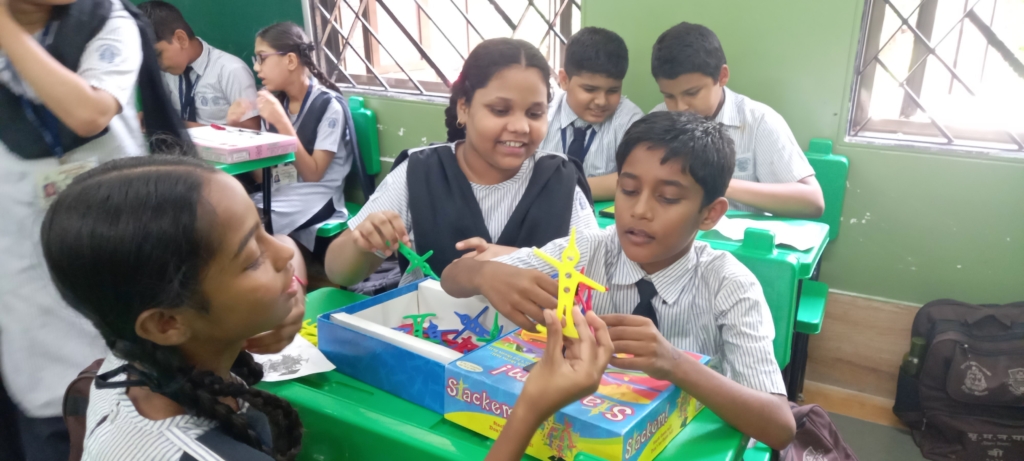
The real world, in any case, is often a politically violent and an economically insecure place—anything but a playground. Is it possible that the condition of our world both reflects and reinforces a prevailing degree of attachment insecurity. If so, the greatest hope for interrupting this dangerous feedback loop is to support and restore a basic sense of security generated, reflected, and reinforced by attuned play. Not only does play provide critical resources for dealing with stress and engendering well-being as adults, but repeated play can also rewire the brain, establishing and reinforcing the neural pathways that lead to the development of playfulness.
Source: Origins of Play and Playfulness, Gwen Gordon; Lego Foundation, learning through play, nov 2017; Guided Play:Where Curricular Goals Meet a Playful Pedagogy, Deena Skolnick Weisberg, Kathy Hirsh-Pasek, and RobertaMichnick Golinkoff, 2013; Learning through play, Lego Foundation, February 2019; The future of play, Lego Learning Institute
Toybank’s Play2Learn programme benefits children in Mumbai’s Govandi settlements
In a study conducted in 2012, it was found that Toybank’s Play2Learn programme sessions brought about improvements in children living in informal settlements of Govandi, Mumbai in India
The study was conducted over a period of three months with 28 children. Through the play sessions, these children were closely monitored over a period of three months by the teachers at Apnalaya’s centres. The teachers were provided sheets, which were based on international play therapy indicators, and the data was divided under the categories: social and emotional skills, life skills, motor skills, fine motor skills and language skills.
The findings of the study revealed that three months after the play sessions, the children showed a 23.46% rise in social and emotional skills; 25.95% rise in life skills; 33.33% improvement in motor skills; 29.03% improvement in fine motor skills and 21.17% rise in language skills.
In addition, Toybank also conducted a quick and easy measure of attendance levels in government schools in Mumbai. After our Play2Learn programme sessions were introduced, there was an increase in attendance. The attendance increased by 45%. Children, who were missing school on Saturdays started attending their classes owing to these play sessions.
It was also noticed that there was a 50% increase in the number of children who performed well in English, in their scholarship exam. The games that helped them the most were: Opposites, Similar word, Word builder, Sentence maker.
While India assures children of their right to education, health and protection, another basic right — Right to Play — remains unrecognised, undervalued and unadopted. Over the years, Toybank has focused on ensuring children have access to play through its Play2Learn Programme.
Source: 3-month preliminary assessment study by The Opentree Foundation’s flagship project, Toybank – Development Through Play with Apnalaya in August – September – October 2012
Toybank’s Play2Learn programme increases curiosity, attention span in children
In a research conducted by The Opentree Foundation under the Toybank project between 2017 and 2020, it was found that Toybank’s Play2Learn programme led to 10x increase in curiosity levels of children, 5x increase in honesty levels, and 2x increase in attention span.
At Toybank, we adopt the Conscious Play™ approach to enable children from vulnerable communities to alleviate stress, build resilience and overcome probable adversity. Across 585 Play2Learn centres in 12 districts across Maharashtra, India, we provide safe spaces to over 75,000 at-risk children to be on track with their mental well-being, as well as socio-emotional and cognitive development.
In early 2017, Toybank’s Play2Learn programme commenced in 13 Maharashtra Housing Board (MHB) schools at the informal settlements in Malwani, Mumbai, India. Children at MHB, growing up in challenging circumstances, needed to be equipped beyond a basic checklist of development and success. Our Conscious Play™ approach taught children to adapt, take risks, develop skills, explore alternatives, share and co-exist with each other.
Through a baseline, midline and endline study over the course of three years, we conducted an impact study of its Play2Learn programme and tracked five key behavioural characteristics of children in these centres. This was done with a pre-designed, semi-structured questionnaires, which was used to conduct in-depth interviews with 64 teachers (Class 1 to 8) in MHB, who represented 1,927 children.
The study showed our Play2Learn programme’s impact on 5 key behavioural characteristics:
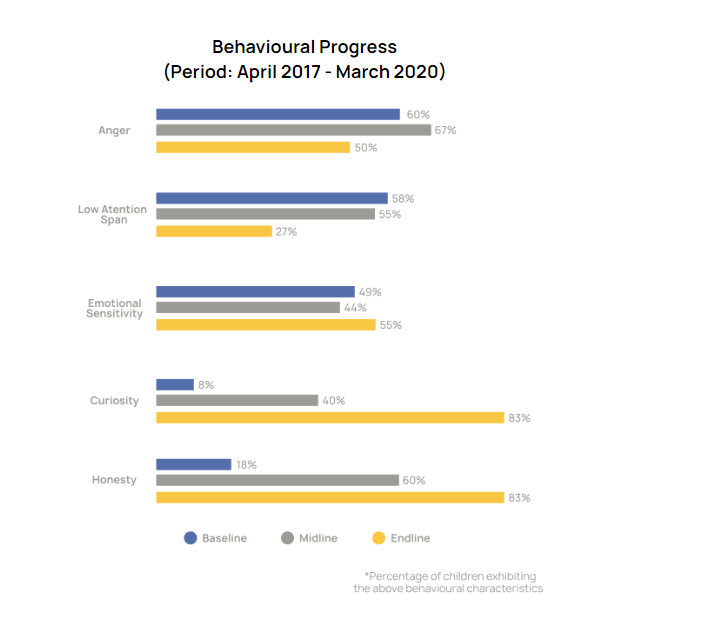
Rise in curiosity levels
The circumstances Malwani’s children grow up in hamper their drive for exploration and learning. With the set-up of Toybank’s Play2Learn Centers, these children had age and developmentally appropriate learning experiences that gave an outlet to their curiosity. Through our ‘Habit Formation’ module, they were encouraged to rise above difficulties and face the challenges. In the early days of our intervention, these children would avoid alphabetical, numerical and strategic games. Their confidence was boosted in our Play2Learn programme sessions, where they shed their inhibitions and explored challenging games with curiosity.
Increase in honesty levels
We interviewed teachers about whether children took ownership of their actions (accepting mistakes, taking queries to teachers without hesitation, trusting peers and teachers). Before our interventions, the classrooms witnessed instances of bullying, teasing and intolerance. Children didn’t trust their peers, let alone seek refuge in teachers, whom they feared and never bonded with. But once our programme made playtime an essential part of their schedule, they started playing in mixed groups and have more empathy for each other. The ‘Habit Formation’ module taught them positive ways of living with others. Teachers became children while playing with them and gradually students opened up to them as well.
Decrease in anger and aggressive behaviour
Difficult circumstances cause distress in children’s personal lives and academics, affecting their relationships with their classmates and impeding their opportunities to learn. Along with our Play2Learn programme session rules of taking turns, patience, negotiation and problem solving, as well as the Anger Management module where children learn to cope with anger, jealousy and other such emotions, the children sstarted to exhibit more kindness and respect than they already did in their circles. They now channeled and practised these good habits with everyone.
Decrease in hyperactive tendencies and distractions/Increase in focus and attention
With the introduction of our play interventions, children were more interested in learning. They gradually learned to wait, play step-by-step, listened and followed instructions attentively. Alongside the games, ice-breakers like ‘Orange-Lemon-Banana’, ‘Traffic Signal’, ‘Clap activities’, etc. taught them self-control, listening skills, ways to be calm and avoid distractions.
Increase in emotional sensitivity
The multiplayer feature of many of our games ensured children played with each other and made friends, became empathetic and sensitive towards each other. Many activities such as ‘Just like me’ have made children aware that we all face challenges in life and that they aren’t alone. They can talk about it to their friends or a trusted person and find a whole array of solutions to cope with these emotions and recover their positivity.
Current practices in classrooms constrain a child’s intrinsic need to learn (curiosity), paving way for boredom, absenteeism, and disinterest in learning (lack of attention). Children may retort to temper tantrums (aggressive behaviour) because of emotional reasons, like not being able to cope with or describe their feelings. Making children more reflective (honest) of their actions individually and how they can affect others (emotional sensitivity) is the need of the hour. Through Toybank’s Conscious Play™ approach at MHB schools, children continue to learn to adapt, take risks, develop skills, explore alternatives, and share and co-exist with each other. These skills will not only help them navigate through adversities and successes that come their way today but will also prepare them for future endeavours.
– SHWETA CHARI, CO-FOUNDER AND CEO, THE OPENTREE FOUNDATION
Source: 3-year impact study in Malwani, informal settlements in Mumbai, India by The Opentree Foundation in April 2017 – March 2020.
The transformative power of play: More than just fun
In a world that often prioritises productivity and achievement, the importance of play can be easily overlooked. However, renowned psychiatrist Dr. Stuart Brown, in his inspiring TED Talk titled “Play Is More Than Just Fun,” sheds light on the profound impact that play has on our lives. At Toybank, we wholeheartedly believe in the transformative power of play and how it can shape the lives of children.
In this blog post, we delve into Dr. Stuart Brown’s insightful talk and explore the significance of play in fostering creativity, resilience, and overall well-being.
Play as a fundamental need:
Dr. Stuart Brown emphasises that play is not just an activity for children, but a fundamental need that extends throughout our lifespan. Play is the gateway to learning, exploration, and self-expression. It fuels our imagination, stimulates curiosity, and allows us to engage fully in the present moment.The link between play and creativity:
Dr. Brown highlights the strong connection between play and creativity. Through play, we discover new possibilities, experiment with different ideas, and cultivate innovative thinking. Whether it’s building with blocks, creating artwork, or engaging in imaginative play, children develop crucial problem-solving and critical thinking skills that lay the foundation for a lifetime of creativity.Play as a catalyst for resilience:
Play provides a safe space for children to navigate challenges, overcome obstacles, and develop resilience. As Dr. Brown explains, through playful experiences, children learn to adapt, collaborate, and persist in the face of setbacks. They build emotional resilience, learning to manage stress and regulate their emotions effectively.The social benefits of play:
Play also serves as a powerful tool for building social connections and fostering empathy. In play, children learn to navigate social dynamics, negotiate, and cooperate with others. They develop essential social skills such as communication, empathy, and conflict resolution, which are vital for building healthy relationships and thriving in a diverse society.
Dr. Stuart Brown’s enlightening TED Talk reinforces what we have always known at Toybank – play is more than just fun; it is a fundamental aspect of human development. By providing children with opportunities for play, we empower them to grow, learn, and express themselves. Play has the power to shape resilient, creative, and compassionate individuals who can positively impact society.
At Toybank, we are committed to creating safe and inclusive spaces where at-risk children can experience the transformative power of play. Through our play programmes, we strive to ensure that every child has the opportunity to explore, discover, and develop their full potential.
Remember, play is not just a luxury; it is a necessity for a brighter and more fulfilling future.
Source: Play Is More Than Just Fun. TED Talk. Dr. Stuart Brown. (2008, May)
‘Adult memories of childhood play’ study: Path to brighter futures
In the 1980s, researcher Dr. Bergen and researchers Wen Liu and Geng Liu surveyed American and Chinese college students about what they remembered as the most important play experiences of their elementary years.
The study, published in the International Journal of Educology in 1997, revealed that the majority of American college students remembered pretend play as the most significant play activity (52%), while the majority of Chinese students recalled games with rules as the most important activity (59%). Chinese students were more likely to say that their childhood play affected their personality (58%), while American students were more likely to say that play influenced their choice of vocation or hobbies as an adult (41% and 34%, respectively).
Even now I love to imagine myself doing something, then I set a goal and do it.
American students typically credited pretend play for their positive adult abilities
Despite these interesting cultural differences, the majority of Chinese and American students stated that their primary motivation for play was “fun.”
Games have made me brave, decisive, self-confident and able to deal with things quickly.
Chinese college student revealed how playing games with rules resulted in positive personality traits as an adult
There is no denying that play is fun, and certainly fun is its biggest draw. However, children also develop critical cognitive, emotional, social, and physical skills as they play. Research has shown that play contributes to proper brain development. The skills children learn through play in the early developmental years set the stage for future learning and success from the kindergarten classroom to the workplace.
Every day hundreds of children across Maharashtra embark on their journey of joyful discovery through Toybank’s play programmes. They are learning how to learn, how to get along with each other and deal with life’s situations all through the power of play.
Source: The Strong National Museum of Play. (n.d.). When I Was a Kid: Adult Memories of Play
In Jamaica, playing is a serious business: Early childhood stimulation study
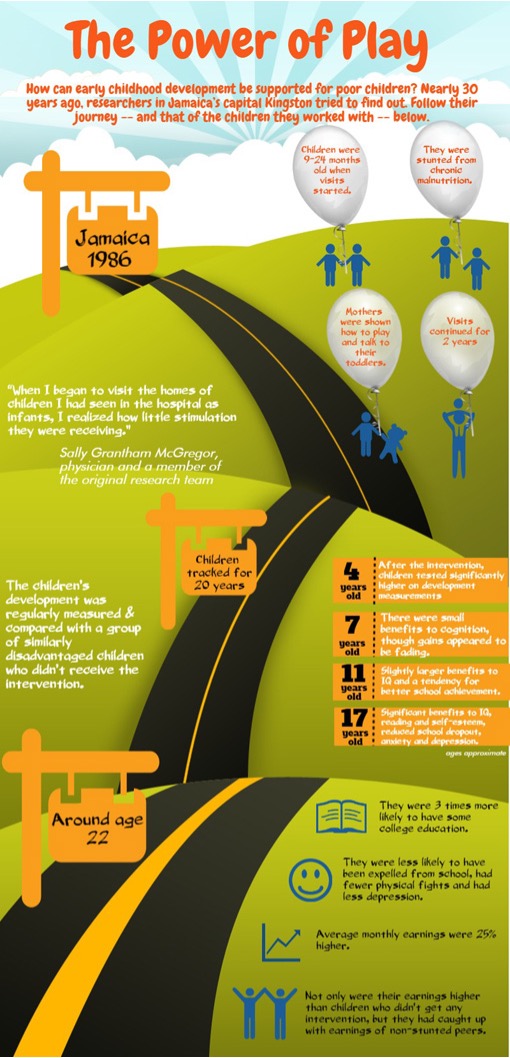
We had the simple idea that if we get mothers to play more with their children, it would help the children’s brain to develop and they would catch up with their fortunate peers.– Christine Powell, Senior Lecturer, University of the West Indies
- More than 20 years ago, researchers in Jamaica sought to boost stunted, disadvantaged children by teaching their mothers to stimulate them using talk and play.
- An impact evaluation allowed researchers to measure the programme’s effectiveness by comparing beneficiary children with similarly disadvantaged children whose mothers didn’t get the programme.
- The children have been tracked ever since and the results have been remarkable. Watch the video below.
Results:
Source: The World Bank

